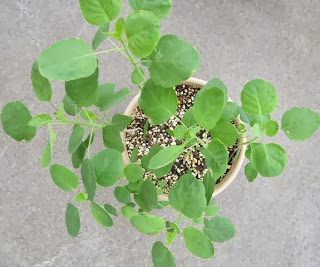Other names for Papalo include ....
- Papaloquelite
- Ruda de Gallina
- Gallenzaza
- Mexikanischer Koriander
Papalo is native to Mexico, Central and South America.
It can grow up to 6 feet in ideal growing conditions, but growth can be restricted when grown in pots.
It forms branches along the main stem producing green leaves with a hint of blue. Attractive purple brownish flowers are produced at the end of the branches.
The leaves are one to two inches long, oval in shape and contain oil glands which give this herb its strong flavor and scent which seems to get stronger as the leaves age.
The oil glands can be seen as small dents or holes on the leaf's surface.
 |
| Papalo leaf showing oil glands |
The flavor of the leaves can be best described as a combination of parsley with a hint of arugula, cilantro and citrus.
 |
| Papalo seedlings |
How to Grow Papalo as an Herb ....
- Seeds may be sown directly in the ground.
- Seeds may also be planted indoors for earlier harvest.
- Grow in well draining soil watering regularly.
- Space the plants around 1 to 1 1/2 feet apart.
- Prefers full to partial sun locations.
Papalo is always consumed fresh and gives salads and sandwiches a distinct taste.
In Mexico it is used in soups, stews, grilled meats and salads where it is added to the food just before serving. It is also an important ingredient in popular sandwiches in Mexico, such as the Cemitas, named for the type of bread that it is made with originating in Puebla, Mexico, containing a variety of meats and cheeses.
Papalo's healthly properties include lowering high blood pressure and it is used to treat liver ailments in some parts of the world.
Another benefit of papalo is that it is said to repel insects.
Copyright © Bob Walsh 2013
www.BobWalshPlumeriaCare101.com
www.BobWalshFrangipaniPlumeriaPflege.com
www.HowToGrowPlumeriaFrangipani.com